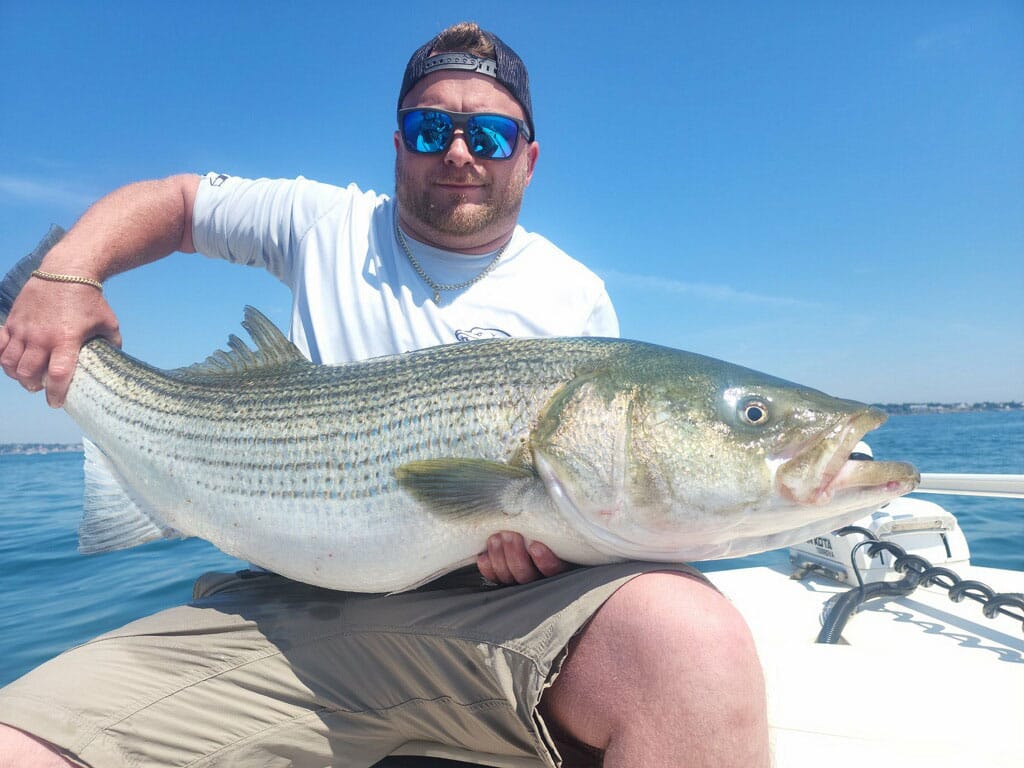
Hot Spot: Boston Harbor
Species: Striped Bass
Captain: Captain Brian Coombs, Get Tight Sportfishing
“Bass fishing has been pretty good this summer,” according to Captain Brian Coombs of Get Tight Sportfishing in Boston Harbor. Coombs had just returned from a double header, running two charters in one day. “The fish are biting better in the afternoon,” he said.
During his summer trips, Coombs searches Boston Harbor and the Massachusetts coast for stripers. When he finds feeding bass, he casts large soft plastics or topwater lures. If the bass have lock jaw, Coombs turns to fishing with live menhaden.
The typical day starts early with Coombs looking for striped bass feeding on the surface. The early bite is topwater, so he starts with a nine-inch Doc plug or a 10-inch, unweighted Slug-Go soft plastic. “BKK has a new Titan Rider 8/0 weightless worm hook hook with a huge gap,” he suggests. He also likes a three-ounce Al Gag paddletail with a plastic skirt. His favorite colors are white, bone and silver flash.
To cast big lures to striped bass, Coombs uses a seven-foot, 11-inch Shimano Grappler Type C spinning rod and 5000 series Shimano Twin Power reel. For unweighted soft plastics, he uses a seven-foot, six-inch Shimano Terramar X rod and Twin Power reel. Coombs spools the reel with 40 pound PowerPro braid and a short leader of 30 pound fluorocarbon.
When Coombs turns to live-bait fishing, he uses a Thunnus spinning reel with the baitrunner function. “I have a weird way of rigging my live baits,” he says. The rig starts out with a 8/0 BKK circle hook tied to three feet of 30 pound fluorocarbon leader. He ties a 220-pound-test swivel to the end of the fluorocarbon. To the braided mainline, he ties another swivel with an eight-inch piece of 60 pound monofilament. Then, he slides a three-ounce egg sinker over the 60-pound mono and ties the short leader to the swivel on the 30-pound fluorocarbon. The short section of heavy leader and swivels keep the egg sinker from rubbing on the braided mainline. He explains: “Braided line isn’t as abrasion resistant as monofilament.”
When Coombs approaches a school of menhaden, he drops the live menhaden below the school where he expects striped bass are waiting. He says his side-imaging sonar plays a big part in his success. “I can drive through an area and see fish on either side of the boat.” He can also mark striped bass holding under a school of menhaden. To get the most accuracy with his side-image sonar, he uses a Humminbird Apex 13 fish finder and a through hull transducer.
Coombs attributes the great striped bass fishing to cold water that has stayed close to shore all summer. “The wind hasn’t blown east all summer,” he says. “An abundance of west wind pushes warmer water offshore leaving cool water in its wake. The water temperature has been in the low 60s,” says Coombs. This means the striped bass are more likely to feed all day long and he is finding fish in more areas. He laughs and says, “The bass aren’t concerned about the water temperature so they do what they want.”
In the next few weeks, Coombs expects more bluefish to move into the area. “First we find them close to the beach, then they move offshore to join the striped bass on the menhaden schools,” he says. “We got into blues up to 14 pounds earlier this week,” he says, adding the encounter is a good sign of great fishing to come through the end of summer.








